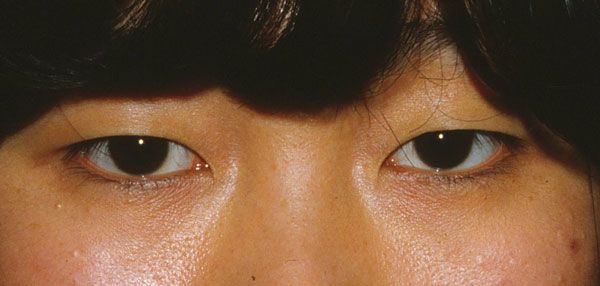
The desire for a natural eyelid crease or “double eyelid” is very popular in Asian cultures. Its estimated that 50% of the Asian population naturally have a single eyelid. The double lid gives the upper eyelid a visible crease, and makes the eyes look brighter and more open. For women, it is easier for them to apply eye makeup on eyelids with the sought after crease.
Asian Blepharoplasty Surgeon
Since the mid 1990s, Oculoplastic surgeon Dr. Amiya Prasad, M.D. has been a highly sought after specialist for East Asian blepharoplasty. He was featured in World Journal (a major Chinese language publication) and Chinese World TV. Because of his work on performing revision surgery on patients who had unsuccessful asian upper eyelid surgery done elsewhere.
As an Oculofacial plastic surgeon, Dr. Amiya Prasad highlights the importance of understanding that Asian eyes are anatomically different from Western eyes. Asian double eyelid surgery requires the performing surgeon to have a thorough understanding of the anatomy of East Asian eyes.
In fact, eyelid surgery is considerably more complex than most people appreciate. Ethnicity, age, gender and skin quality as well as general health need to be well integrated into developing a proper strategy.
The delicate epicanthal fold that lies in front of the eye must be treated with finesse. So that proper rejuvenation does not mar the natural beauty of this type of eye. A common mistake many plastic surgeons make in performing this surgery is “Americanizing” or “Europeanizing” the eyelids. Resulting in a very unnatural appearance and the loss of the characteristics that are unique to the Asian eye.
Types of Asian Eyelids
Although Asian eyelids are seemingly lumped together, it must be said that Asians do not have only one type of eyelid. There are 4 types of Asian eyelids:
- eyelid with no crease,
- eyelid with partial crease,
- eyelid with multiple creases, and
- eyelid with double crease.
These natural creases are positioned differently with every patient, thus, the procedure always varies greatly. Other times, the symmetry and definition of their lid creases also vary from day to day, so many Asian patients desire to have a stable and single crease to enhance the appearance of their eyes. This is where cosmetic surgery can help.
Blepharoplasty vs. Epicanthoplasty
Blepharoplasty refers to eyelid surgery of both the upper and lower eyelids. In Asian patients, the aim of the upper blepharoplasty is to create a crease in the upper eyelid using different techniques.
Located in the inner corner of the eye, the epicanthal fold is a prevalent feature among the Asian population. An epicanthoplasty is a procedure to change the epicanthal fold so the inner corners of the eyes (inner canthus) is revealed. The eyelid crease can look longer and the eye can appear wider.
Asian Double Eyelid Surgery Procedure
Pre-Surgery Evaluation
During your consultation with Dr. Prasad, various factors will be evaluated including:
- Your age
- Your gender
- Your skin thickness and quality
- Your fat volume under the skin
- Your healing from past procedures
- Your unique anatomy around your eyes
Based on this evaluation, Dr. Prasad will determine whether you are a suitable candidate for Asian eyelid surgery.
Asian Double Eyelid Surgery
Depending on the amount of excess skin and fat under the upper eyelid, Dr. Prasad will choose to perform a non-incisional or an incisional procedure.
For the non-incisional approach small openings are made in the skin. A stitch is passed through to attach the upper eyelid skin to the underlying levator muscle muscle, which is responsible for lifting the eyelid. This will result in the eyelid skin folding in when the eyes are opened.
This incisional approach is used to create the eyelid fold, if there is extra skin and fat on the upper eyelid. After Dr. Prasad draws the appropriate pattern, an incision will be made in the upper eyelid area. Typically, a small volume of fat will be removed in order for the upper eyelid crease to be defined without creating a hollow area.
Dr. Prasad performs double eyelid surgery in approximately 1 hour. However, preparation time and immediate post-operative recovery means you’ll be at the clinic for approximately 3 hours. The time of the surgery can be longer when performed with other procedures.
Asian Blepharoplasty Recovery
There are three phases to wound healing recovery, some of which overlap with each other. First is the inflammatory phase, which occurs in the first week after surgery. During this phase, there is a fair amount of redness, swelling, and elevation of the eyelid and the eyelid crease.
Second is the proliferative phase, wherein the body begins producing enough blood supply and collagen to facilitate healing.
And third and last is the collagen remodelling or wound remodelling phase, wherein the disorganized collagen becomes organized, and begins to flatten out and soften. This is the phase wherein incision lines go from being thick to flat.
Keep in mind that the last phase, collagen remodelling, can last for up to one to two years.
Asian Blepharoplasty Before and After Pictures
See Asian eyelid surgery pictures gallery


